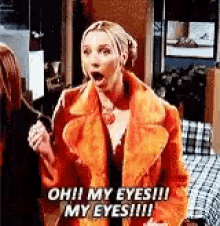Interpreting for Deaf people with vision conditions? Your outfit is part of the message

It’s Deafblind Awareness Week! And we’re here to light up your screen (figuratively… and with appropriate contrast, of course) with insight into something not talked about enough: supporting Deaf people with vision conditions.
Now, before you go imagining total darkness and silence, let’s clear things up—Deafblindness isn’t a one-size-fits-all experience. It covers a wide range, from people with mild tunnel vision and hearing loss to those with profound combined sight and hearing impairments.
And guess what? Many Deaf people live with additional vision conditions. So, let’s talk about how interpreters can offer clear, respectful, accessible support that doesn’t accidentally create more barriers.
Let’s start with a classic oops: you show up in a white shirt, confident and ready to interpret… only to realise that your client can’t see your hands properly.

Here’s why: white clothing reflects light, which can make signing difficult to track for someone with limited vision. It’s the visual equivalent of trying to read neon text on a bright background. Ouch.
What to wear instead?
Clothing isn't just about style—it’s an accessibility tool. The goal? Create contrast between your hands and what’s behind them, so Deaf people with vision conditions can follow your signing clearly.
👉 If you have lighter skin: Wear solid, dark colours like navy, charcoal, dark green, or burgundy. These shades help your hands stand out without overwhelming the eyes.
👉🏿 If you have darker skin: Choose lighter, solid colours such as pale blue, soft grey, cream, or even some pastels. These provide the contrast needed without being harsh or reflective.
What to avoid:
-
Busy patterns or stripes (unless you want your hands to play hide-and-seek).
-
Bright white—it can reflect light and cause glare, especially tricky for low-vision audiences.
-
Sequins, rhinestones, or shimmer—save them for Saturday night, not the classroom.
-
Jewellery is lovely. But on an interpreter? It’s a potential visual landmine.
-
Rings, bracelets, long nails, shiny watches… all of these can distract from the hands, especially for someone trying to follow BSL with narrowed visual fields or light sensitivity.
💡 Top tip: Keep it minimal. Keep it matte. Keep it moving smoothly.
Want to dive deeper into interpreter dress code and why it matters? We've got a brilliant post for you right here: Sign Language Dilemmas: What Does the Interpreter Wear?
For Deaf clients with visual conditions, positioning matters. A lot.
Sit or stand in the best-lit area—preferably with lighting from the front, not behind. (No one wants to lipread a silhouette.)
💡 Ask your client what works best. Some may prefer interpreters closer, others may need tactile BSL or hands-on support. It’s not one-size-fits-all and that’s OK!
What About Tactile BSL?
Tactile BSL is a lifeline for many Deafblind individuals. Hands-on signing, literally, where the person receiving the interpretation places their hands lightly on the signer’s hands to feel the signs.
It requires:
-
Trust and training
-
Good hygiene
-
And (you guessed it) no sharp nails or chunky rings
If you’re a CSW or interpreter supporting a Deafblind client, make sure you’re trained—or seek training from a professional organisation.
✨Bonus Tips✨
-
Use larger font sizes on printed materials or phones.
-
Offer clear verbal cues when navigating environments: “We’re about to turn left,” “There’s a step ahead,” etc.
-
Avoid crowded, noisy areas for important conversations (sensory overload is real).
-
If you're using visual media or presentations, describe what’s on screen—this is basic access, not a bonus feature.
Every Deaf or Deafblind person has different needs and preferences. The best interpreters? They ask respectful questions and listen.
Try:
🗣️ “Where would you like me to stand?”
🗣️ “Is this lighting OK for you?”
🗣️ “Would tactile BSL or hands-on support be helpful today?”
It shows care, awareness, and professionalism. Win-win.
For those with both hearing and vision loss, a little planning goes a long way.
So this Deafblind Awareness Week, let’s pledge to be more aware, more adaptable, and just a bit less shiny.

